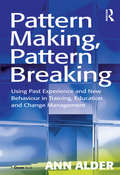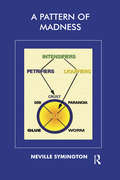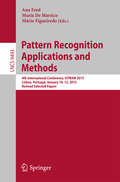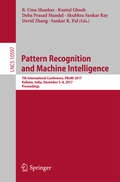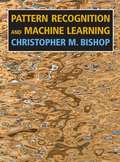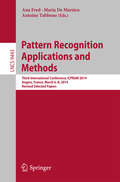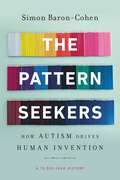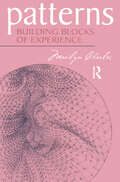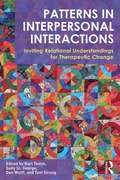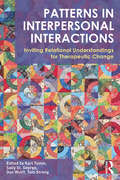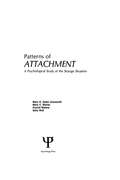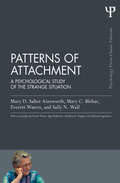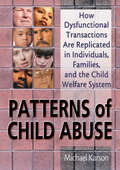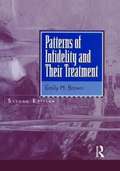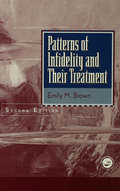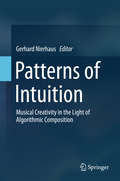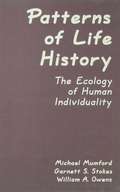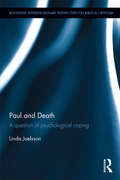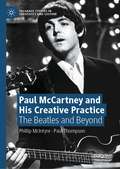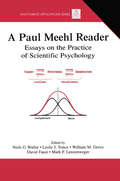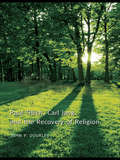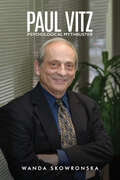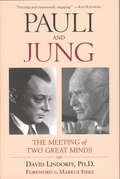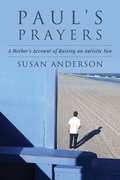- Table View
- List View
Pattern Making, Pattern Breaking: Using Past Experience and New Behaviour in Training, Education and Change Management
by Ann AlderRapid changes in technology, the nature of organisations, non-traditional career progression, globalisation and ’virtual worlds’ mean that we need to become ever more effective learners in order to keep pace with the demands placed upon us. Our patterns of understanding, the ways in which we make sense of our work and our world, hardly become fixed before we are asked to change them and form new ones. The ability to build patterns is fundamental to our ability to learn. Ann Alder’s Pattern Making, Pattern Breaking explores the ways in which educators and facilitators can work to help students build those patterns that will be most useful to them. These may be ’technical’ patterns of language, number, sequence or process. They may be thinking patterns that support problem-solving, creativity, logical analysis or empathy. They may be patterns of behaviour that demonstrate trust, influence or integrity in relationships. Ann also illustrates how you can teach students to break patterns: to help them move on in the learning process by recognising and rejecting long-held patterns of behaviour or assumptions that are unhelpful or redundant. Formal education and training do not necessarily produce learners who are well-resourced to take advantage of opportunities that arise and to avoid some of the stresses that uncertainty, ambiguity or imposed change place upon them. So, perhaps one of the most important patterns that we can explore and understand as we move forward, in a changing world, is our own pattern of learning. Whether you are a parent, teacher, tutor, trainer, coach or manager, you need to be an effective facilitator of learning and this book is the perfect starting place.
A Pattern of Madness: Philosophical Foundations For A Theory Of Madness
by Neville SymingtonAuthor of many respected psychoanalytic works including Narcissism: A New Theory, Emotion and Spirit, Making of a Psychotherapist and Spirit of Sanity, the distinguished psychoanalyst Neville Symington's latest book expands, refines and deepens what has become an ever more impressive, far-reaching and absorbing inquiry into the nature of madness and sanity. It is Symington's central contention that the core psychopathology of our times can be identified and designated as narcissism, although self-centredness, egoism or solipsism might serve equally well. Critical of psychiatry's mere symptomatology, and of much psychotherapeutic practice as superficial and sterile, the present volume probes compellingly into the narcissistic pattern in an effort to delineate its structure in all its complexity and thereby gain a measure of perspective and distance from this most intractable of psychic states.
Pattern Recognition: Applications and Methods
by Ana Fred Maria De Marsico Mário FigueiredoThis book constitutes the thoroughly refereed post-conference proceedingsof the 4th International Conference on Pattern Recognition, ICPRAM 2015,held in Lisbon, Portugal, in January 2015. The 20 revised full papers were carefully reviewed and selectedfrom 145 submissions and describe up-to-date applications of patternrecognition techniques to real-world problems, interdisciplinaryresearch, experimental and/or theoretical studies yielding new insightsthat advance pattern recognition methods.
Pattern Recognition and Machine Intelligence
by B. Uma Shankar Kuntal Ghosh Deba Prasad Mandal Shubhra Sankar Ray David Zhang Sankar K. PalThis book constitutes the refereed proceedings of the Second International Conference on Pattern Recognition and Machine Intelligence, PReMI 2007, held in Kolkata, India in December 2007. The papers are organized in topical sections on pattern recognition, image analysis, soft computing and applications, data mining and knowledge discovery, bioinformatics, signal and speech processing, document analysis and text mining, biometrics, and video analysis.
Pattern Recognition And Machine Learning (Information Science And Statistics)
by Christopher M. BishopThis is the first textbook on pattern recognition to present the Bayesian viewpoint. The book presents approximate inference algorithms that permit fast approximate answers in situations where exact answers are not feasible. It uses graphical models to describe probability distributions when no other books apply graphical models to machine learning. No previous knowledge of pattern recognition or machine learning concepts is assumed. Familiarity with multivariate calculus and basic linear algebra is required, and some experience in the use of probabilities would be helpful though not essential as the book includes a self-contained introduction to basic probability theory.
Pattern Recognition Applications and Methods
by Antoine Tabbone Maria De Marsico Ana FredThis book constitutes the thoroughly refereedpost-conference proceedings of the Third International Conference on PatternRecognition, ICPRAM 2014, held in Angers, France, in March 2014. The 18 revised full papers were carefully reviewed andselected from 179 submissions and describe up-to-date applications of PatternRecognition techniques to real-world problems, interdisciplinary research,experimental and/or theoretical studies yielding new insights that advancePattern Recognition methods.
The Pattern Seekers: How Autism Drives Human Invention
by Simon Baron-CohenA groundbreaking argument about the link between autism and ingenuity.Why can humans alone invent? In The Pattern Seekers, Cambridge University psychologist Simon Baron-Cohen makes a case that autism is as crucial to our creative and cultural history as the mastery of fire. Indeed, Baron-Cohen argues that autistic people have played a key role in human progress for seventy thousand years, from the first tools to the digital revolution.How? Because the same genes that cause autism enable the pattern seeking that is essential to our species's inventiveness. However, these abilities exact a great cost on autistic people, including social and often medical challenges, so Baron-Cohen calls on us to support and celebrate autistic people in both their disabilities and their triumphs. Ultimately, The Pattern Seekers isn't just a new theory of human civilization, but a call to consider anew how society treats those who think differently.
Patterns: Building Blocks of Experience
by Marilyn CharlesIn recent years, various tributaries of psychoanalytic and developmental theory have flowed into our dawning understanding of the role of early sensory and affective experiences in the construction of our personal worlds. In Patterns: Building Blocks of Experience, Marilyn Charles shows how such primary experiences coalesce into patterns, those essential units of meaning that capture the unique subjectivity of each individual. Frequently "known" by their prosody or affective melody, patterns come to have profound meanings that we utilize in constructing basic notions of self and other. Through pattern, Charles holds, we approach elusive meanings through dimensions of shape, contour, and affective resonance. Such patterned understandings, in turn, become a mode of interchange through which we touch one another in ways that go beyond the overtly physical. Analytic patients, Charles finds, have often led early lives too full of "noise" to use their early sensory and affective experiences constructively. Such patients tend to live out patterns that operate unconsciously and have become literally incomprehensible. Analytic communication, by drawing explicit attention to such patterned experience, provides new images that intrude on ingrained patterns of thinking about the self and other. Out of the productive clash of analytically co-constructed images and the invariant patterns of the past emerge new conceptions of what the patient may choose to be in the present moment. Through it all, Charles displays an admirable willingness to sit in difficult spaces and to work through troubling therapeutic impasses from the inside out, rather than from some point of ostensible safety. This finely textured and richly evocative study, which grows out of Charles' extensive clinical work with artists, writers, and musicians, is a signal contribution to developmental theory, clinical theory, and the psychology of creativity.
Patterns in Interpersonal Interactions
by Edited by Karl Tomm Sally St. George Dan Wulff Tom StrongIn this book we present a comprehensive view of a systemic approach to working with families, initiated by Karl Tomm more than two decades ago at the Calgary Family Therapy Centre in Canada. The contributors of this edited book articulate the IPscope framework as it was originally designed and its evolution over time. We invite you, experienced professionals and new family therapists, to join with us to explore some of the mysteries of human relationships. While the focus on our explorations revolves around clinical mental health problems and initiatives towards solutions, the concepts are applicable in many domains of daily life. They highlight the ways in which we, as persons, invite each other into recurrent patterns of interaction that generate and maintain some stability in our continuously changing relationships. The stabilities arise when our invitations become coupled and can be characterized as mutual; yet, they always remain transient. What is of major significance is that these transient relational stabilities can have major positive or negative effects in our lives. Consequently, we could all potentially benefit from greater awareness of the nature of these patterns, how particular patterns arise, and how we might be able to influence them.
Patterns in Interpersonal Interactions: Inviting Relational Understandings for Therapeutic Change (Routledge Series on Family Therapy and Counseling)
by Karl Tomm, Sally St. George, Dan Wulff, and Tom StrongIn this book we present a comprehensive view of a systemic approach to working with families, initiated by Karl Tomm more than two decades ago at the Calgary Family Therapy Centre in Canada. The contributors of this edited book articulate the IPscope framework as it was originally designed and its evolution over time. We invite you, experienced professionals and new family therapists, to join with us to explore some of the mysteries of human relationships. While the focus on our explorations revolves around clinical mental health problems and initiatives towards solutions, the concepts are applicable in many domains of daily life. They highlight the ways in which we, as persons, invite each other into recurrent patterns of interaction that generate and maintain some stability in our continuously changing relationships. The stabilities arise when our invitations become coupled and can be characterized as mutual; yet, they always remain transient. What is of major significance is that these transient relational stabilities can have major positive or negative effects in our lives. Consequently, we could all potentially benefit from greater awareness of the nature of these patterns, how particular patterns arise, and how we might be able to influence them.
Patterns of Attachment: A Psychological Study of the Strange Situation (Psychology Press And Routledge Classic Editions Ser.)
by M. D.S. Ainsworth M. C. Blehar E. Waters S. WallFirst published in 1979. Ethological attachment theory is a landmark of 20th century social and behavioral sciences theory and research. This new paradigm for understanding primary relationships across the lifespan evolved from John Bowlby's critique of psychoanalytic drive theory and his own clinical observations, supplemented by his knowledge of fields as diverse as primate ethology, control systems theory, and cognitive psychology. By the time he had written the first volume of his classic Attachment and Loss trilogy, Mary D. Salter Ainsworth's naturalistic observations in Uganda and Baltimore, and her theoretical and descriptive insights about maternal care and the secure base phenomenon had become integral to attachment theory. Patterns of Attachment reports the methods and key results of Ainsworth's landmark Baltimore Longitudinal Study. Following upon her naturalistic home observations in Uganda, the Baltimore project yielded a wealth of enduring, benchmark results on the nature of the child's tie to its primary caregiver and the importance of early experience. It also addressed a wide range of conceptual and methodological issues common to many developmental and longitudinal projects, especially issues of age appropriate assessment, quantifying behavior, and comprehending individual differences. In addition, Ainsworth and her students broke new ground, clarifying and defining new concepts, demonstrating the value of the ethological methods and insights about behavior. Today, as we enter the fourth generation of attachment study, we have a rich and growing catalogue of behavioral and narrative approaches to measuring attachment from infancy to adulthood. Each of them has roots in the Strange Situation and the secure base concept presented in Patterns of Attachment. It inclusion in the Psychology Press Classic Editions series reflects Patterns of Attachment's continuing significance and insures its availability to new generations of students, researchers, and clinicians.
Patterns of Attachment: A Psychological Study of the Strange Situation (Psychology Press & Routledge Classic Editions)
by Mary C. Blehar Everett Waters Mary D. Ainsworth Sally N. WallEthological attachment theory is a landmark of 20th century social and behavioral sciences theory and research. This new paradigm for understanding primary relationships across the lifespan evolved from John Bowlby’s critique of psychoanalytic drive theory and his own clinical observations, supplemented by his knowledge of fields as diverse as primate ethology, control systems theory, and cognitive psychology. By the time he had written the first volume of his classic Attachment and Loss trilogy, Mary D. Salter Ainsworth’s naturalistic observations in Uganda and Baltimore, and her theoretical and descriptive insights about maternal care and the secure base phenomenon had become integral to attachment theory. Patterns of Attachment reports the methods and key results of Ainsworth’s landmark Baltimore Longitudinal Study. Following upon her naturalistic home observations in Uganda, the Baltimore project yielded a wealth of enduring, benchmark results on the nature of the child’s tie to its primary caregiver and the importance of early experience. It also addressed a wide range of conceptual and methodological issues common to many developmental and longitudinal projects, especially issues of age appropriate assessment, quantifying behavior, and comprehending individual differences. In addition, Ainsworth and her students broke new ground, clarifying and defining new concepts, demonstrating the value of the ethological methods and insights about behavior. Today, as we enter the fourth generation of attachment study, we have a rich and growing catalogue of behavioral and narrative approaches to measuring attachment from infancy to adulthood. Each of them has roots in the Strange Situation and the secure base concept presented in Patterns of Attachment. It inclusion in the Psychology Press Classic Editions series reflects Patterns of Attachment’s continuing significance and insures its availability to new generations of students, researchers, and clinicians.
Patterns of Child Abuse: How Dysfunctional Transactions Are Replicated in Individuals, Families, and the Child Welfare System
by Michael Karson Elizabeth SparksInterpret the hidden meaning of family roles to help children at risk!Because dysfunctional patterns are closed systems that serve a secret purpose, they are almost impossible to change from the outside. Patterns of Child Abuse helps you recognize the purpose behind the patterns and offers successful strategies for entering the pattern in order to help family members without joining it and becoming part of the dysfunction. Patterns of Child Abuse identifies the most common, most problematic patterns and explores their hidden meanings. Case studies and theoretical discussions demonstrate the ways family patterns are replicated in a child's psyche and the ways the grown-up child replicates the familiar family pattern, forcing the world to bend to the story within. Synthesizing systems theory, behaviorism, and psychoanalysis, Patterns of Child Abuse offers powerful insights as well as practical strategies for dealing with such complex issues as: how to comfort an abused child who cannot bear to be touched why abused children idealize their battering or neglectful parent how borderline personality organization affects individuals and their families handling the sexually powerful teenage girl, the disruptive boy, and the mother of the sexual abuse victim how family patterns operate in therapeutic context why therapists and social workers may encounter conflicts in child welfare cases when and how paradoxical interventions can work Well-written and insightful, Patterns of Child Abuse conveys a sound theoretical model and a sophisticated approach to the psychology of individuals and families for the child welfare professional.
Patterns Of Infidelity And Their Treatment
by Emily BrownThe new edition of this highly-regarded book includes comprehensive discussion of the nature of an affair and the five types of affairs and their underlying dynamics. The author addresses issues regarding revealing the affair, management of the consequences, rebuilding, and treating an unmarried third party, as well as the host of complex issues regarding children and custody arrangements. New material for the second edition includes cybersex and the effects of new technology on fidelity in marriage; the effects of managed care on treatment; marriage to the third party; and a new chapter on affairs and violence.
Patterns Of Infidelity And Their Treatment
by Emily M. BrownThe new edition of this highly-regarded book includes comprehensive discussion of the nature of an affair and the five types of affairs and their underlying dynamics. The author addresses issues regarding revealing the affair, management of the consequences, rebuilding, and treating an unmarried third party, as well as the host of complex issues regarding children and custody arrangements. New material for the second edition includes cybersex and the effects of new technology on fidelity in marriage; the effects of managed care on treatment; marriage to the third party; and a new chapter on affairs and violence.
Patterns of Intuition
by Gerhard NierhausThe present book is the result of a three year research project which investigated the creative act of composing by means of algorithmic composition. Central to the investigation are the compositional strategies of 12 composers, which were documented through a dialogic and cyclic process of modelling and evaluating musical materials. The aesthetic premises and compositional approaches configure a rich spectrum of diverse positions, which is reflected also in the kinds of approaches and methods used. These approaches and methods include the generation and evaluation of chord sequences using genetic algorithms, the application of morphing strategies to research harmonic transformations, an automatic classification of personal preferences via machine learning, and an application of mathematical music theory to the analysis and resynthesis of musical material. The second part of the book features contributions by Sandeep Bhagwati, William Brooks, David Cope, Darla Crispin, Nicolas Donin, and Guerino Mazzola. These authors variously consider the project from different perspectives, offer independent approaches, or provide more general reflections from their respective research fields.
Patterns of Life History: The Ecology of Human Individuality (Applied Psychology Series)
by William A. Owens Michael D. Mumford Garnett S. Stokes Garnett StokesThis work summarizes an ongoing longitudinal study concerned with the nature of human differences as manifest in peoples' life histories. The traditional models for the description of human differences are reviewed, then contrasted with the presentation of alternative models. This volume is also one of the few to investigate different approaches to measurement procedures. Practical applications of these models and the results obtained in a 23 research effort are discussed.
Paul and Death: A Question of Psychological Coping (Routledge Interdisciplinary Perspectives on Biblical Criticism)
by Linda JoelssonThe concept of death, particularly violent death, is prevalent throughout the writings of Paul the Apostle. His letters in the New Testament address this topic from a variety of perspectives, some of which can appear to be almost contradictory. However, this need not be problematic. Paul and Death uses the method of psychological exegesis to show that the different attitudes toward death in Paul’s letters make for a much more coherent discourse if they are seen as an aid to individual and collective psychological coping. Taking the differences between each of Paul’s letters as its starting point, this study suggests that a variety of coping strategies in relation to death may be beneficial depending on the situation, the person, and the stage of the coping process. Drawing on psychologically-oriented hermeneutic theory, and theories about psychological coping in particular, the author argues that each case of psychological coping must be understood in its historical situation, and as strategies emanating from a specific person’s subjective appraisal. Combining theology and biblical studies with modern psychology, this book will be of particular interest to academics and students that are studying the relationship between Religion and notions of Death.
Paul McCartney and His Creative Practice: The Beatles and Beyond (Palgrave Studies in Creativity and Culture)
by Phillip McIntyre Paul ThompsonThis book provides fresh insight into the creative practice developed by Paul McCartney over his extended career as a songwriter, record producer and performing musician. It frames its examination of McCartney’s work through the lens of the systems model of creativity developed by Mihaly Csikszentmihalyi and combines this with the research work of Pierre Bourdieu. This systems approach is built around the basic structures of idiosyncratic agents, like McCartney himself, and the choices he has made as a creative individual. It also locates his work within social fields and cultural domains, all crucial aspects of the creative system that McCartney continues to be immersed in. Using this tripartite system, the book includes analysis of McCartney’s creative collaborations with musicians, producers, artists and filmmakers and provides a critical analysis of the Romantic myth which forms a central tenet of popular music. This engaging work will have interdisciplinary appeal to students and scholars of the psychology of creativity, popular music, sociology and cultural studies.
A Paul Meehl Reader: Essays on the Practice of Scientific Psychology (Multivariate Applications Series)
by Niels G. Waller Leslie J. Yonce William M. Grove David Faust Mark F. LenzenwegerThis new book introduces a new generation to the important insights of Paul Meehl. In addition to selected papers from the classic reader, Psychodiagnosis, this book features new material selected from Meehl's most influential writings. The resulting collection is a tour de force illustrating quantitative analysis of life science problems, an examination of the inadequacy of some methods of analysis, and a review of the application of taxometrics.A Paul Meehl Reader is organized into five content areas: theory building and appraisal - how we discover and test the true causal relations of psychological constructs; specific etiology - an examination of genetic, behavioral, and environmental etiology in psychopathology; diagnosis and prediction - a review of the appropriate use of base rates; taxometrics - a look at Meehl's development of the method he invented; thinking effectively about psychological questions - a critique of correlation research and the power of quantitative thinking in psychology.The Reader features section introductions to orient the reader and provide a context and structure for Paul Meehl's work. The section on diagnosis and prediction features problem sets with solutions to guide the reader through practical applications of the principles described. Accompanying downloadable resources contain footage from Paul Meehl's engaging seminar on clinical versus statistical prediction. This book appeals to advanced students and professionals in psychology, sociology, law, education, human development, and philosophy.
Paul Tillich, Carl Jung and the Recovery of Religion
by John P. DourleyIs religion a positive reality in your life? If not, have you lost anything by forfeiting this dimension of your humanity? This book compares the theology of Tillich with the psychology of Jung, arguing that they were both concerned with the recovery of a valid religious sense for contemporary culture. Paul Tillich, Carl Jung and the Recovery of Religion explores in detail the diminution of the human spirit through the loss of its contact with its native religious depths, a problem on which both spent much of their working lives and energies. Both Tillich and Jung work with a naturalism that grounds all religion on processes native to the human being. Tillich does this in his efforts to recover that point at which divinity and humanity coincide and from which they differentiate. Jung does this by identifying the archetypal unconscious as the source of all religions now working toward a religious sentiment of more universal sympathy. This book identifies the dependence of both on German mysticism as a common ancestry and concludes with a reflection on how their joint perspective might affect religious education and the relation of religion to science and technology. Throughout the book, John Dourley looks back to the roots of both men's ideas about mediaeval theology and Christian mysticism making it ideal reading for analysts and academics in the fields of Jungian and religious studies.
Paul Vitz: Psychological Mythbuster
by Wanda SkowronskaAmerican psychologist, Paul Vitz, was a pioneer critic of the ‘me, me, me’ generation and humanistic psychology which flourished alongside it. He stands out because of the cultural, psychological and spiritual depth of his critique. Mythbusters are rare and Vitz is a mythbuster par excellence, tearing apart several generations of selfism with insight, wisdom and wit. Other critiques came much later. He saw it all at the time. This book takes the reader on a journey into the life and thought of a rare thinker, a questioner of ideological sacred cows, and one of the most original and gifted psychologists of the past century. PAUL VITZ WAS A VISIONARY FOR HIS TIME IN CONFRONTING AND MYTHBUSTING HUMANISTIC PSYCHOLOGY AMIDST ‘A TSUNAMI OF HUMANISTIC ADULATION.’ THIS BOOK GIVES PERCEPTIVE INSIGHTS INTO VITZ'S THOUGHT AND TIMES. WELL WORTH READING! – Catherine MacLaurin, Psychologist, Senior Wellbeing Advisor (SWA), Health and Safety Directorate, NSW Department of Education and Training, Australia THE AMERICAN PSYCHOLOGIST, PAUL VITZ, HAS BEEN A REMARKABLY PRESCIENT AND COURAGEOUS CRITIC OF THE HUMANIST PSYCHOLOGY MOVEMENT, HEADLINED BY CARL ROGERS. IN THIS BOOK, WANDA SKOWRONSKA HAS PROVIDED A THOROUGH AND CONVINCING ACCOUNT OF VITZ’S WORK. HER BOOK DESERVES A WIDE READERSHIP. – Colin Patterson STD, Dean and Permanent Fellow of the former John Paul II Institute, Melbourne, Australia. IN HER BOOK, WANDA SKOWRONSKA MASTERFULLY NARRATES THE PHILOSOPHICAL, THEOLOGICAL, AND HISTORICAL CONTEXT OF THE DEVELOPMENT OF HUMANISTIC PSYCHOLOGY, ESPECIALLY THAT OF CARL ROGERS, THROUGH THE LENS OF PAUL C. VITZ’S LIFE AND PUBLICATIONS. THIS WORK CRITIQUES THE INFLUENCES OF CONTEMPORARY PSYCHOLOGY’S HUMANISTIC ORIGINS OF SELF-FULFILMENT THEORIES AND CULTURAL MARXISM AND HONOURS THE LIFELONG WORK OF PAUL VITZ, WHO IS UNDOUBTEDLY ONE OF THE MOST SIGNIFICANT CATHOLIC PSYCHOLOGISTS OF OUR TIMES. – Professor Craig Steven Titus, S.Th [http://s.th/].D./Ph.D. Divine Word University, USA.
Pauli and Jung
by Markus Fierz David LindorffNobel prize-winning atomic physicist Wolfgang Pauli experienced a moral crisis over what he called the "dark side of science,"shortly after his 1932 prediction of the existence of the neutrino, a particle of cosmic importance to physics. Located at the Institute for Advanced Study in Princeton during the Manhattan Project-the initiative which drew scientific luminaries like Robert Oppenheimer to oversee the development of the atomic bomb-Pauli was curiously withdrawn, alienated by the military's increasing influence over the pursuit of science.Following the bombings of Hiroshima and Nagasaki, Pauli's dreams illuminated his primary concern, what he termed the "psycho-physical problem," or the need for science to become morally accountable by considering "irrational phenomena." This dilemma led Pauli to the prominent depth psychologist C.G. Jung, whose own pioneering theory of synchronicity posited coincidence as a reliable supplement to rational thought. Over the next twenty years, the two great thinkers exchanged letters detailing their philosophical differences regarding the psycho-physical problem, Pauli's dreams and the symbolic relation of psyche and matter at the archetypal level.Author David Lindorff supplements the remarkable letters Pauli and Jung exchanged with his own insightful interpretation. By illustrating how Pauli's dreams complemented and informed his groundbreaking ideas, Lindorff skillfully supports both Pauli and Jung's perspectives of reality and suggests the dire importance of unifying the rational scientific approach of physics with the irrational influence of the unconscious.
Pauli and Jung
by David Lindorff Markus FierzThe pioneering work of Nobel prize-winning physicist Wolfgang Pauli led to developing the bombs that decimated Hiroshima and Nagasaki. Desperate over this outcome, Pauli sought help from the eminent depth psychologist, C. G. Jung. Their long correspondence provides the powerful and unique record of a mature scientist's inner journey. It also has had a tremendous impact on scientific and psychological thought ever since. Pauli and Jung is a lucid interpretation of Pauli's ideas and dreams that forcefully validates his belief in the inseparable union of science and spirituality. Far ahead of their time, Wolfgang Pauli and C. G. Jung both knew this union is essential for the future of humanity and the survival of the planet.
Paul's Prayers: A Mother's Account of Raising an Autistic Son
by Susan AndersonRecipient of the Catholic Writers Guild 2018 Seal of Approval“A journey of compassion, frustration, and triumph . . . Anderson’s love for her son marks this beautiful portrait of family and faith.” —Publishers WeeklyPaul's Prayers is the story of a moderately autistic young man navigating life with a spiritual intelligence that runs further than most people can walk. Written by Paul's mother, this insightful memoir gives readers a unique look at the challenges and joys of raising her autistic son in a large Catholic family. The first of six children, Paul's early years were an exciting and confusing time for his parents. At the time, very little information on autism and its early signs was available, and the fact that the disorder is a spectrum ranging from mild to severe was not widely known. Unpredictable outbursts and sensitivities to light and schedule disruptions lead Paul's parents to refer to his condition as "The Marauder." The Marauder sweeps over the hospital nursery as the fluorescent lights blind Paul's eyes. The Marauder throws his black cape over the Christmas holidays, stealing four-year-old Paul's speech for three long days. In school, The Marauder keeps other students at bay, leaving Paul isolated and alone. Finally a developmental assessment gives some clarity to the exhausted family: Paul is on the autism spectrum, and they will all have to adjust their perspectives. Small victories emerge as Paul begins to reach developmental milestones in creative ways. Six years of piano lessons lead to a dramatic improvement in reading skills. A jaunt through the mountains with his father introduces Paul to his talent for running; with his brothers, he joins the high school cross country running team, which goes on to win the state championship. After high school, Paul works for the family business and attends college. Throughout this intimate memoir, every day is a challenge to be met with creative thinking, patience, and faith. Paul finds comfort in contemplative prayer and the support of his family when the world around him becomes too chaotic. As her son grows up, Susan Anderson learns how to cope with autism and embrace the importance of faith in the things unseen. Her family's experience is a beacon of light for those who find themselves on a similar path.
